Horseshoe
crabs can be found along Assateague Island's miles of unspoiled beach
and inland bays during your summer vacation . During spring, horseshoe
crabs move onto Assateague's beaches to mate and lay their eggs. They
prefer beach areas that are located within protected coves or bays
because of the calm water. Horseshoe crabs are most abundant between
the Atlantic coastal areas of Virginia and New Jersey.
Many
shorebirds returning from their wintering areas in South America stop
along Assateague's shores to enjoy eating the horseshoe crab's eggs.
These migratory birds rely on the eggs during the trip to Canadian
breeding grounds. The eggs provide food for sandpipers, gulls, sanderlings,
and hundreds of thousands of shorebirds (at least 20 species of shorebirds).
Horseshoe crab eggs are also a preferred food for flounder, trout,
silversides, crabs, and whelk.
Horseshoe
Crabs inhabited the earth 100 million years before Dinosaurs. Their
fossils data back 300 million years. Horseshoe crabs are closer related
to spiders than crabs and have several pairs of eyes. The horseshoe
crab feeds mostly on razor clams and other shellfish as well as marine
worms. They shed their shell in order to grow and can live to 18 years
of age.
The
species located in Japan is now protected and has been declared endangered.
The blood of the horseshoe crabs is used to test new medicines for
the presence of harmful bacteria. The horseshoe crab has been around
many years, however during this century their numbers have been threatened
due to over harvesting them for fertilizer and bait for commercial
fishing. Coastal Native Americans once used horseshoe crab tails to
tip their fishing spears and the shells for bowls.

